In the Learning and Development industry, everyone knows about learning styles and how people learn best. The VARK model of learning styles is a popular one that suggests there are primarily four types of learners - Visual, Auditory, Read/Write, and Kinesthetic.
It was in the 1970s that learning styles gained popularity, and several models came up. Neil Fleming designed the VARK model in 1987. To identify the type of learners people are, Fleming came up with a self-report inventory with a series of questions.
Let us take a look at the VARK model in detail.
VARK Model
Visual
- Does visualizing content help you remember it better?
- Do you have to see the content to remember it?
If your answers to the above questions are yes, then you are most likely a visual learner.
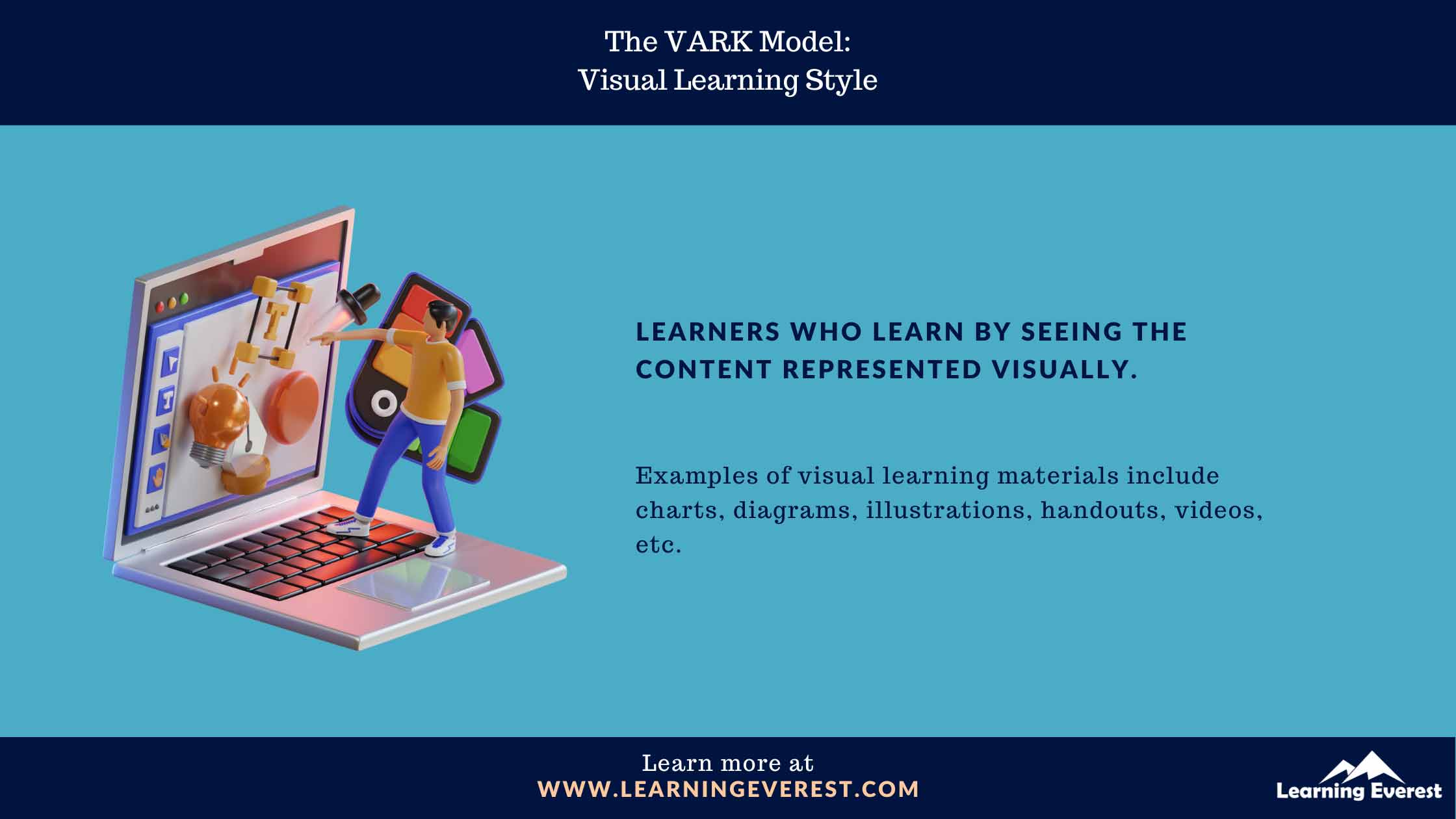
The VARK Model – Visual Learning Style
Learners who learn by seeing the content represented in graphics like charts, diagrams, illustrations, handouts, videos, and other visual material are visual learners. Thus, a learner sees the information to process it fully. A visual learner may be distracted by movement or actions they see, but not by noise. The visual content here must be more than just words in the charts and diagrams. It could include symbols or arrows that explain the relationship between the topics in the content.
Auditory
- Do you create songs to remember information?
- Do you prefer listening to information rather than reading it from a book?
If your answers to the above questions are yes, then you may be an auditory learner.
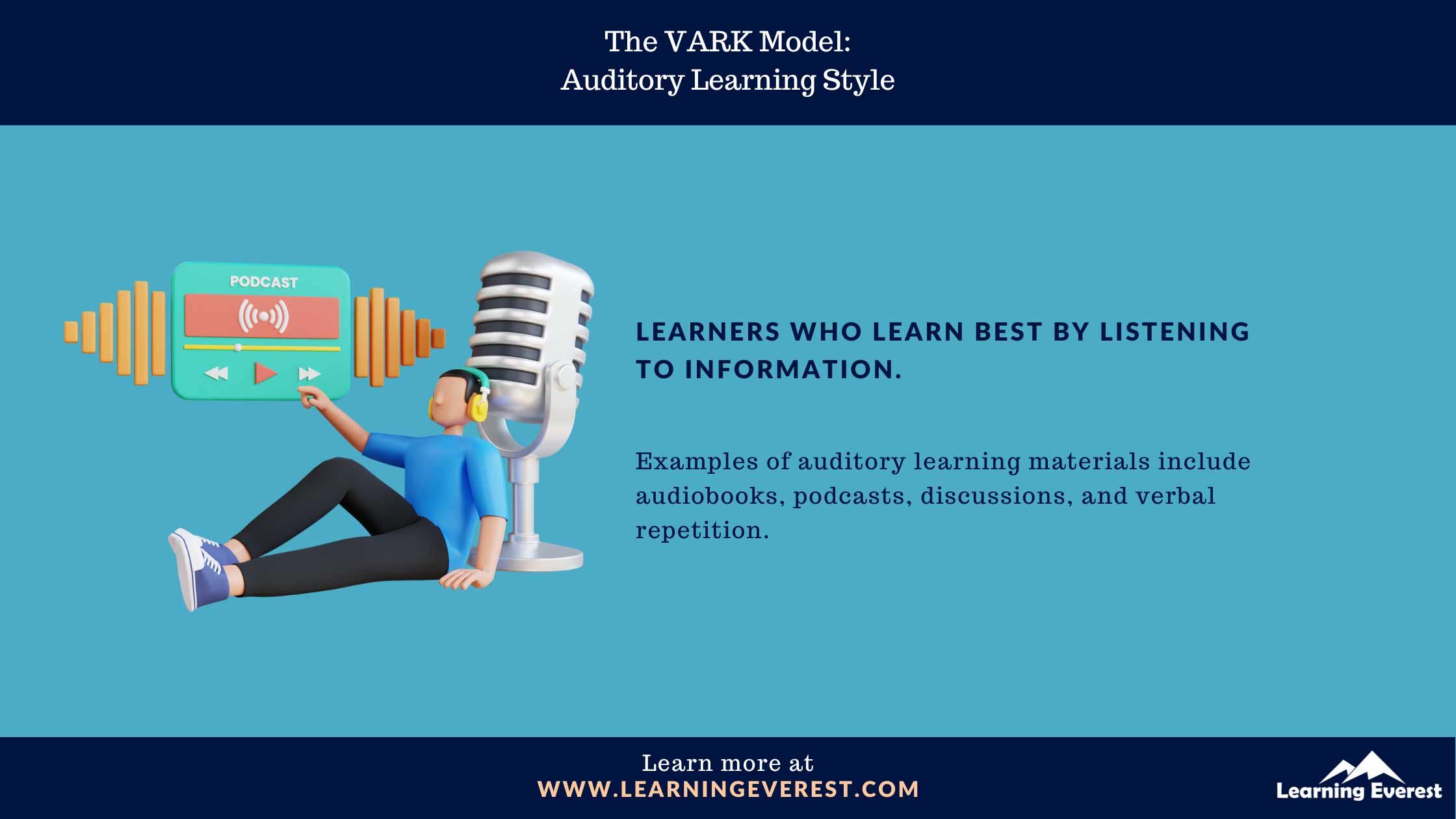
The VARK Model – Auditory Learning Style
Auditory learners learn best when they hear information. They find audiobooks and podcasts more useful than textbooks and can understand content through audio lectures. They learn better through aural discussions; however, such learners may be easily distracted by noise. These learners also prefer talking out loud or repeating what they have just heard to understand it better. They could rephrase the content and say it out loud or ask obvious questions.
Read / Write
- Do you find making lists, notes, and presentations a way to learn?
- Do you like reading your textbook and learn better through it?
If your answer to these questions is yes, you prefer reading and writing when you learn.
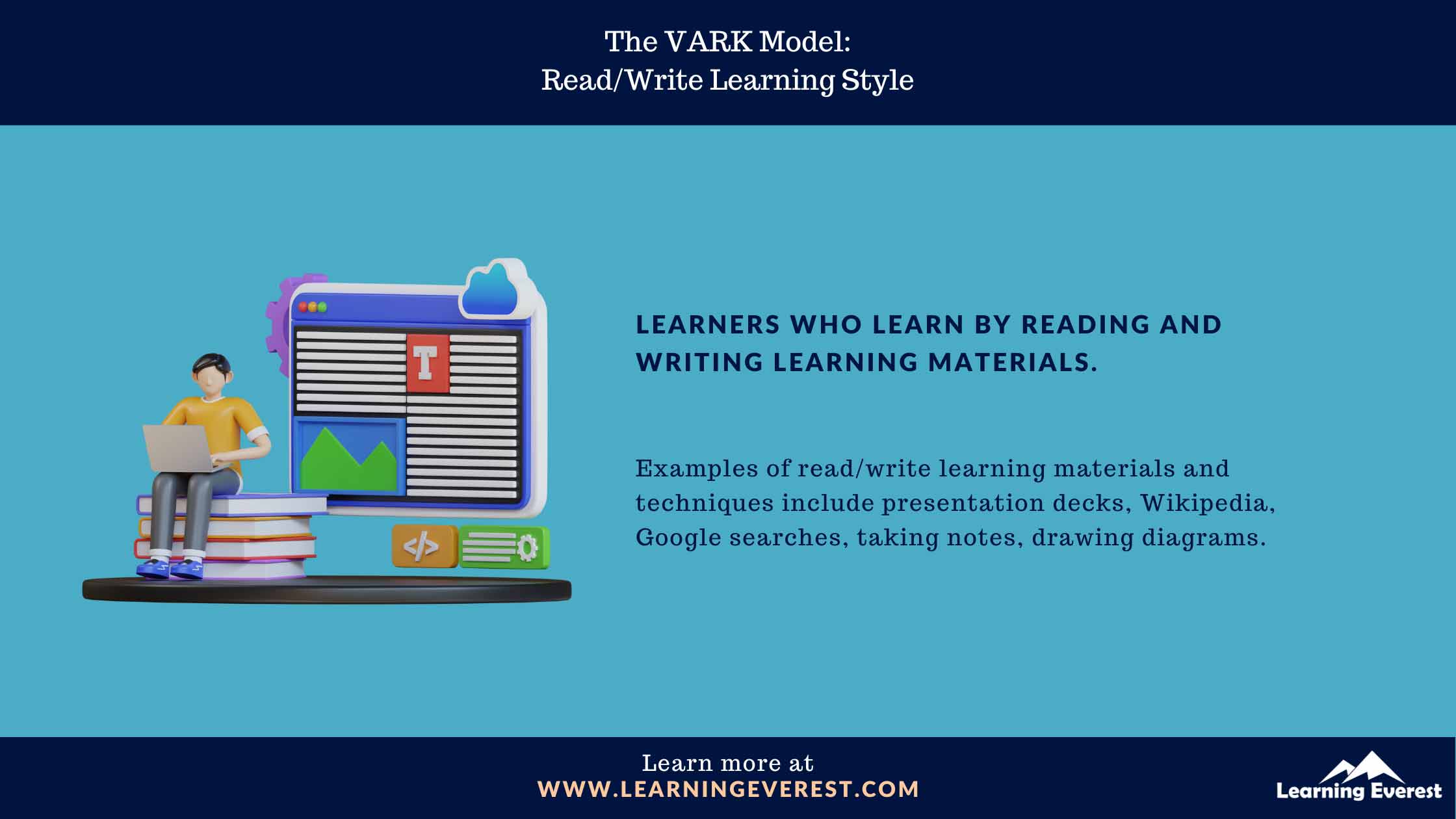
The VARK model – Read Write Learners
Reading and writing learners prefer to read and write the information given to learn better. Such learners would be the ones taking notes in class and drawing things to remember content better. Today, learners who prefer PowerPoint, GOOGLE, and Wikipedia to gain information and learn are those who fall in this category.
Kinesthetic
- Do you enjoy applied activities like painting, mechanics, sports, and woodwork?
- Do you find that practising something by doing it helps you learn better?
You are most definitely a kinesthetic learner if your answer is yes to both the above questions.
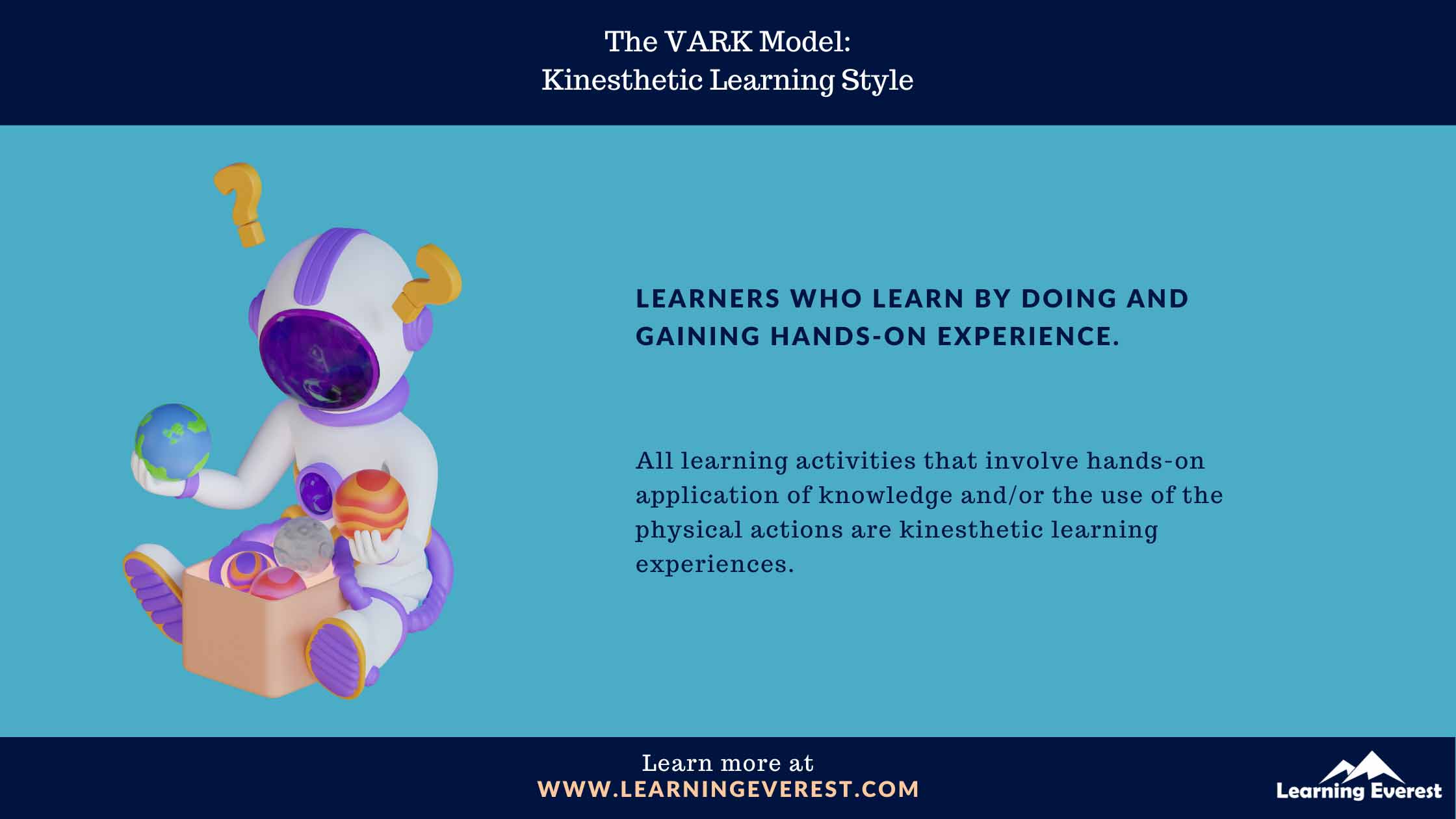
The VARK Model – Kinesthetic Learners
Kinesthetic learners learn best by doing and prefer hands-on experiences. They generally do not learn a new skill if they must see or listen to information. Such learners prefer demonstrations, simulations, videos, or movies of real happenings or things and then apply these to make learning more concrete.
One major criticism that the VARK model has is that one cannot categorize learners to be visual, auditory, reading/writing, or kinesthetic exclusively. Some learners prefer one over the other, but several others fall somewhere in the middle and learn best when combining some of these. Such learners are called multimodal. In a study conducted by VARK in the year 2020, 237537 people responded to an online questionnaire which revealed that 66% of people were multimodal.
VARK Model and Online Learning
Since all learning worldwide is happening online, it has been a bit of a challenge for educators and trainers to convey information. For the Read/ Write learners, it is easier as written material is made available to them. Even for Visual learners, this written material could be easily absorbed as it would contain graphs, charts, maps, and more to cater to their learning style.
Thus, the difficulty is faced by auditory and kinesthetic learners as distance plays an essential role in conveying material using Auditory and Kinesthetic modes. Technology, however, has progressed to the extent that we can overcome some problems and cater to the needs of the Auditory and Kinesthetic learners.
Auditory learners can attend online classes via Zoom or Skype and listen to live lectures. Another option is to listen to recorded lectures or webinars. Similarly, since actual lab-visits and demonstrations are not possible for Kinesthetic learners, videos that provide hands-on information about experiments and demonstrations can be used. Though these are in no way the same as actually attending a demonstration or listening to the trainer in a classroom setting, they are better substitutes that serve the purpose during difficult times.
Advantages of VARK Model
The VARK model has clear advantages that would help when applied appropriately. Read on to know more.
Successful model: This is a successful model as it promotes learning and can be adapted to various settings. Though this is seen as a drawback, differentiating learners can be advantageous for pairing them up for tasks and thus delivering the content effectively. When used in the training sector, organizations can conduct training that can deliver appropriate content to learners on the go and save time and effort.
Self-esteem: When learning opportunities that cater to their needs are presented to the learners, they learn better and experience a boost in their self-esteem when they realize they are doing well.
Disadvantages of VARK Model
Let us look at a few disadvantages of the VARK model.
Categorizing and restrictive: Like the criticism levelled at it previously, the VARK model categorizes learners and often restricts them to one mode. Some learners prefer more than one mode, and they must be taken into consideration.
Implementation: Creators of the courses must be careful in creating content and implement the model to cater to all the categories of learners. If this implementation fails, the information conveyed becomes meaningless and results in a loss of time and effort.
Time constraints: Including material that caters to all learners can be time-consuming. Efforts must then be taken to make use of the time efficiently.
Thus, the VARK model can be complicated to apply to all but can successfully achieve the desired learning outcomes when appropriately used.
Infographic
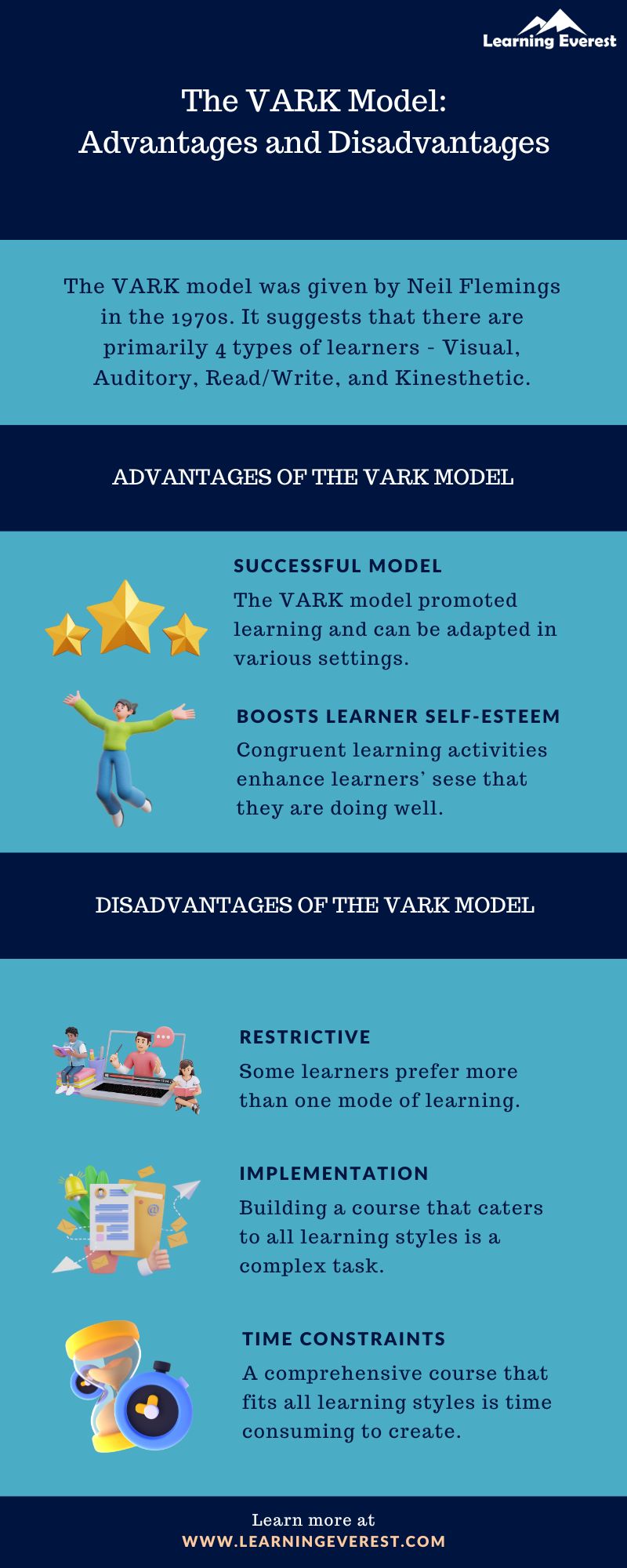
The VARK Model Advantages and Disadvantages
Knowledge Check
Frequently Asked Questions (FAQs)
Who created the Vark model?
Neil Fleming designed the VARK model in 1987.
What is the VARK model?
The VARK model of learning styles is a popular one that suggests there are primarily four types of learners – Visual, Auditory, Read/Write, and Kinesthetic.
What are the four learning styles?
The VARK model of learning styles suggests that there are primarily four types of learners – Visual, Auditory, Read/Write, and Kinesthetic.
What are the advantages of the VARK model?
The VARK model is successful as it promotes learning and can be adapted to various settings. When learning opportunities that cater to their needs are presented to the learners, they learn better and experience a boost in their self-esteem when they realize they are doing well.







VARK is very useful for different kinds of learners